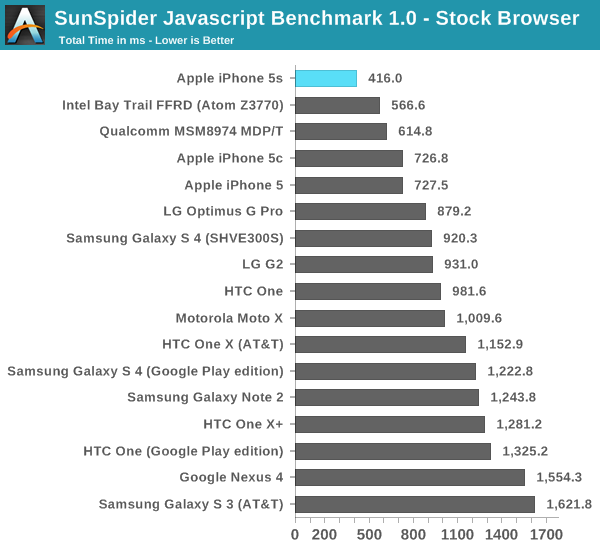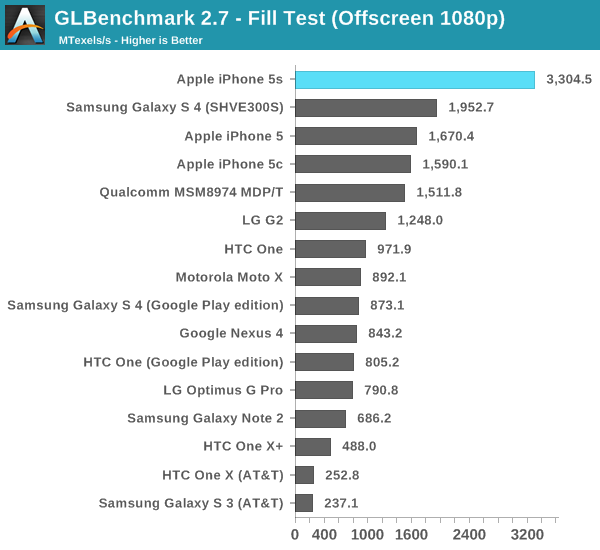- Brian and I saw the gold iPhone up close at Apple’s Town Hall event and it really doesn’t look bad at all. It’s a very subtle gold finish rather than a gaudy gold brick effect. I think gold is likely the phone I’d opt for simply because it’d be very different than everything else I have, but otherwise space grey is probably the best looking of the three devices to me.
- NVIDIA and Samsung, up to this point, have gone the processor license route. They take ARM designed cores (e.g. Cortex A9, Cortex A15, Cortex A7) and integrate them into custom SoCs. In NVIDIA’s case the CPU cores are paired with NVIDIA’s own GPU, while Samsung licenses GPU designs from ARM and Imagination Technologies. Apple previously leveraged its ARM processor license as well. Until last year’s A6 SoC, all Apple SoCs leveraged CPU cores designed by and licensed from ARM.With the A6 SoC however, Apple joined the ranks of Qualcomm with leveraging an ARM architecture license.
-I always thought the transition from 2 to 4 cores happened quicker in mobile than I had expected. Thankfully there are some well threaded apps that have been able to take advantage of more than two cores and power gating keeps the negative impact of the additional cores down to a minimum. As we saw in our Moto X review however, two faster cores are still better for most uses than four cores running at lower frequencies. NVIDIA forced everyone’s hand in moving to 4 cores earlier than they would’ve liked, and now you pretty much can’t get away with shipping anything less than that in an Android handset. Even Motorola felt necessary to obfuscate core count with its X8 mobile computing system. Markets like China seem to also demand more cores over better ones, which is why we see such a proliferation of quad-core Cortex A5/A7 designs. Apple has traditionally been sensible in this regard, even dating back to core count decisions in its Macs. I remembering reviewing an old iMac and pitting it against a Dell XPS One at the time. This was in the pre-power gating/turbo days. Dell went the route of more cores, while Apple chose for fewer, faster ones. It also put the CPU savings into a better GPU. You can guess which system ended out ahead.
-Integer performance is up 44% on average, while floating point performance is up by 67%. Again this is without 64-bit or any other enhancements that go along with ARMv8. Memory bandwidth improves by 35% across all Geekbench tests. I confirmed with Apple that the A7 has a 64-bit wide memory interface, and we're likely talking about LPDDR3 memory this time around so there's probably some frequency uplift there as well.The result is something Apple refers to as desktop-class CPU performance.
- Both the new advanced SIMD instructions and AES/SHA instructions are really designed to enable a new wave of iOS apps.
-Safari, Mail, everything all made the move to 64-bit right away. Given the popularity of these first party apps, it’s not just the hardware that’s 64-bit ready but much of the software is as well. The industry often speaks about Apple’s vertically integrated advantage, this is quite possibly the best example of that advantage. In many ways it reminds me of the Retina Display transition on OS X.
Running A32 and A64 applications in parallel is seamless. On the phone itself, it’s impossible to tell when you’re running in a mixed environment or when everything you’re running is 64-bit. It all just works.
-Apple continues to build its own SoCs and invest in them because honestly, no one else seems up to the job.
-The dual-core A7 is now the fastest SoC we've tested under SunSpider, even outpacing Qualcomm's Snapdragon 800 and ARM's Cortex A15. Apple doesn't quite hit the 2x increase in CPU performance here, but it's very close at a 75% perf increase compared to the iPhone 5

-A7's performance here is downright amazing. Once again there's a performance advantage over Snapdragon 800 and Cortex A15, both running at much higher peak frequencies.
http://images.anandt...h7335/58180.png
-Compared to the iPhone 5, the 5s shows up at over 2.3x the speed of last year's flagship.
-Granted we're comparing across platforms/browsers here, but the 5s as a platform does extremely well in Intel's favorite benchmark.
http://images.anandt...h7335/58194.png
-Apple’s A7 is the first shipping mobile silicon to integrate ImgTec’s PowerVR Series 6 GPU.

-It is also the first device we've tested capable of breaking the 30 fps barrier in T-Rex HD at its native resolution.Given just how ridiculously intense this test is, I think it's safe to say that the iPhone 5s will probably have the longest shelf life from a gaming perspective of any previous iPhone.
![]() ) . Σε mobile devices τι gpu rendering να τρέξεις όμως; Τι επεξεργασία εικόνας να κάνεις που δεν θα επαρκεί η ήδη υπάρχουσα CPU?Τι επεξεργασία σοβαρή να κάνεις σε οθόνη 4"(σα μαρτύριο ακούγεται); Σε ipad αλλάζει η λογική γιατί μπορείς να κάνεις κάποια από τα παραπάνω.(αν και ακόμα δεν υπάρχουν τέτοιες εφαρμογές να εκμεταλλευτούν την υπολογιστική ισχύ)
) . Σε mobile devices τι gpu rendering να τρέξεις όμως; Τι επεξεργασία εικόνας να κάνεις που δεν θα επαρκεί η ήδη υπάρχουσα CPU?Τι επεξεργασία σοβαρή να κάνεις σε οθόνη 4"(σα μαρτύριο ακούγεται); Σε ipad αλλάζει η λογική γιατί μπορείς να κάνεις κάποια από τα παραπάνω.(αν και ακόμα δεν υπάρχουν τέτοιες εφαρμογές να εκμεταλλευτούν την υπολογιστική ισχύ)














